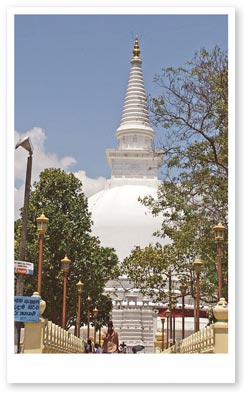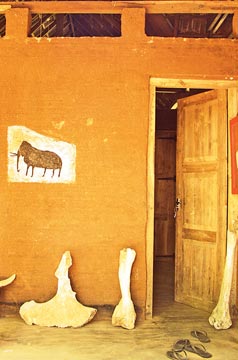|

Fertile paddy fields in Mahiyanganaya |
Beguiling Bintenna
There is more to this flat land than the vast expanse
of greenery:
by Mahil Wijesinghe
Mahiyanganaya, located in Badulla District in the Uva Province, is
not the ideal tourist destination. Yet, it has many historical and
religiously important places of interest that are worth visiting. Though
the area is predominantly known for its Vedda or Adhivasi population, an
indigenous group of people believed to be the original inhabitants of
the island, Mahiyanganaya also has a strong Buddhist heritage.
Mahiyanganaya, also known as Bintenna, which means flat land, is
located eastwards of the steep eastern falls of the central hills. The
relative flatness of the area can be seen while driving from Kandy to
Padiyathalawa across Hunnasgiriya, through the famous 18 hairpin bends.
During my visit to Dambana, an ancestral village of the Vedda
community, I came across some interesting places around Mahiyanganaya,
the most significant topographical feature being the mighty Mahaweli
River, which rises from Hortan Plains and drops down to the Hortan
plateau.
The River gathers its strength from the many streams and rivulets
down the mountains. From Minipe, the river flows into the plains beside
the historic Mahiyangana Chaitiya.
|

Monastic monk in Mawaragala
forest hermitage |
|

Historic Mahiyangana Chaitiya |
The River having taken a straight turn encircles the island of
Kalinga, which is the ancient site of the first double diversion of the
Mahaweli. .
The entire Mahaweli plain was irrigated in ancient times by the
waters of the Mahaweli River, which flows across Mahiyanganaya. A part
of the North Central province called System-C, under the Mahaweli
program, has already been supplied with Mahaweli waters. Some 71,000
acres around Mahiyanganaya have been made available for paddy
cultivation. The majority of the people in this fertile area are engaged
in agriculture, with paddy cultivation being the main economic activity.
To the North of Mahiyanganaya lies a placid man-made lake called
Sorabora Wewa, considered a marvelous engineering masterpiece built
during the reign of King Dutugemunu (around 150 BC) by the Vedda clan
chief Bulatha.
Sorabora Wewa
The Wewa was created by damming up a small tributary of the Mahaweli.
Visitors can get a guided tour Sorabora Wewa in a traditional canoe, if
they are up for the adventure. Mahiyanganaya is among the most important
places of veneration for the Buddhists.
It is said that the Buddha first visited Mahiyanganaya with an
invitation from God Saman. The first stupa to be built in Sri Lanka was
on the bank of the Mahaweli River in Mahiyanganaya King Dutugemunu
(161-137) lived in Mahiyanganaya during his march to Anuradhapura to
capture the kingdom invaded by the Tamils. It is said that he enlarge
the Dagoba to a height of 80 cubits.
Today Mahiyanganaya has become a popular place of Buddhist worship,
with devotees making it a regular spot in their pilgrimage.
|

Entrance to the Adhivasi Museum at Dambana |
Another Buddhist place worth visiting around Mahiyanganaya is a
serene forest hermitage in a rocky outcrop called the Mawaragala Forest
Hermitage. It lies in the vicinity of Dambana, 20 kilometres away from
Mahiyanganaya on the Padiyathalawa road.
The Hermitage is haven to a group of Buddhist Bhikkus who practice
meditation and spend a monastic life there. Children from Adhivasi
families have also been ordained as Buddhist monks. For food, they
gather Pindapatha every day.
Abundance of wildlife
The land of Bintenna to the South East of Kandy was once a mighty
forest with an abundance of wildlife.
To the Veddas who made this land their home, the jungles near Dambana
provided the traditional hunting ground. Under the Mahaweli Development
Program in 1980, the Adhivasi people were evacuated from their ancestral
villages and given new settlements in Henannanigala, in System - C. But
still, there are a few places in and around Dambana, where the Adhivasi
people make their living in a traditional manner.
In the deep forest of Dambana, there is a clay structure, which
houses proud historical monuments of the Adhivasi people.
The museum contains rare colour and black and white photographs of
Veddas and the instruments they used to display for the visitors who
come to see the life of the Adhivasi people in Dambana. The reservoir of
Ulhitiya-Ratkinda was constructed under the Mahaweli Program in
Hennanigama, System-C, just 60 kilometres away from Mahiyanganaya, where
most of the Adhivasi community has been given new settlements.
The trans-basin canal has conveyed Mahaweli waters to the Ulhitiya
reservoir and then to the Maduru Oya reservoir.
This reservoir benefits the Adhivasi settlers in Hennanigama,
providing them a new lease of life in the agriculture and fishing
industry.
|

